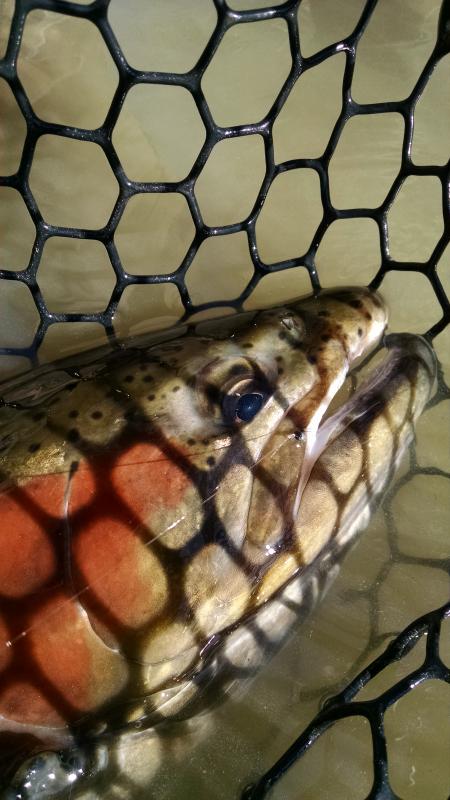Angling Tactics for Low Water Steelhead

In our previous article, we discussed how to approach the problem of a dry fall from a geographical approach. Often, the best tactic to overcome low water conditions is to simply target a bigger river. This is not always practical, or even possible. When forced to deal with the challenge that extreme low and clear water presents, the angler must adjust.
The first important concept relates to the importance of current. Fish stranded in almost completely dead water are absolutely the most difficult to catch. As you move through a section of stream, try first to locate fish near the heads of pools, in pits, or near drop offs. Even in very low water, there are often at least a few fish that can be found hiding under bubbling, turbulent depth changes. Narrow, channelized areas of the stream bed concentrate flows and force water to move through faster than wide, even areas. Avoid places where flows are divided into more than one channel. The more water that runs through the exact spot that you are fishing, the better.
Next in importance is to seek out areas which feature deep, dark hiding places. Edges along breaks in the shale, the bottom of deep slots, and the foot of drop offs are prime examples. Any piece of water that you cannot see the bottom of means that the fish can't see you. Chrome steelhead disappear even in clear water, so don't assume that there are no fish in hole unless you can identify every detail of the bottom. The places that are the most difficult to check for fish are always the most likely places for them to be.
One thing that I have found to be important when fishing to steelhead in all but very stained water is the concept of "long and lean." This method was first designed for fishing long, deep seams from a drift boat while moving. The angler simply flipped the rig off of the side of the boat, occasionally mending it, but never recasting until the run shallowed out. Not only do the flies get deep, they fall gracefully and flutter through the water column. Adapting it to the wade fisherman only requires a longer cast and a mend or two upstream.
The rig consists of 7-10 feet of leader between your indicator and your weight. No more than a BB shot is used, and normally a single No.1 is plenty. Slack near the indicator is very important. Three feet of heavy butt section helps with this, as it retains some memory and the coils on the surface indicate a dead drift. The trick is to cast way ahead of your target, make an immediate upstream mend, and let the rig slowly flutter down in. Pressured fish despise any offering that sinks too quickly and unnaturally. I constantly encounter anglers who use far too much weight to try to get their flies to hang tightly under an indicator. This is not a natural drift at all, as surface currents and bottom currents are in no way equal. As well, heavy rigs cannot follow turbulence. A long, light rig is super sensitive and even the lightest take moves the indicator. These rigs rarely hang up on anything as they have no mass to force the hook into getting stuck on rocks and roots. With a 30 foot upstream cast and a single mend, depths of six feet are easy to achieve.
If you are forced to fish to fish that are laid up in pool tailouts, or suspended in deep slow water, then adjust your rig. Think trout fishing. A long 3x leader of 10 or even 14 feet in length with a size 8 or 10 Stimulator dry is a good standard. Add a single or double dropper to the dry, and make sure it incorporates a small bead head nymph or an egg that sinks. I sometimes forego the bead head in favor of piece of dust shot a foot above a yarn egg on a three foot dropper rig. If you use tin shot, soak them in bleach the night before you fish to turn them black and dull. Tippet for a dropper should be 3x-5x, depending on how clear the water is, but should always be the strongest that you can get away with.
Rods should be downsized from the standard 10 foot seven weight to a six. I hate the idea of a steelhead on a five weight. Only the fastest action fives have enough backbone to turn a steelhead, and they are just plain unethical. Tippet below 4x is as well borderline unethical. Long battles are not cool; they are fish killers. A medium-fast action six weight and some quality 4x still gives a fair amount of leverage. Fish in exceedingly warm water should never see any of these tactics.
Suspended fish are easier targets during early and late periods of the day. Midge hatches are great feeding triggers for steelhead quarantined in slow pools when movement isn't possible. Few anglers remember the concept of "match the hatch" when fishing for steelhead. Midges are tiny. Flies should start at size 16 and go all the way down to size 22. Fly patterns should be purpose built for big fish! Tiemco 2488H hooks are key for steelhead midge tying. 2X heavy wire, wide gap, forged hooks are requirements for any small fly.
Consider a stealthy approach, and cast ahead of the fish with a downstream presentation. Learn how to execute a Reach Cast. Be patient, and consider the slightest bump of your dry a hit. Set the hook lightly, and turn your rod horizontal during the fight to control the fish as best you can. Limit battles to a few minutes.
Low, clear conditions present their challenges. Keep your expectations reasonable, and get out there and work for them.
- Log in to post comments

